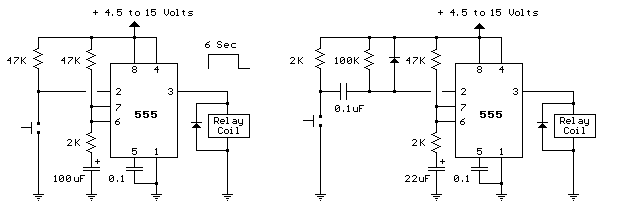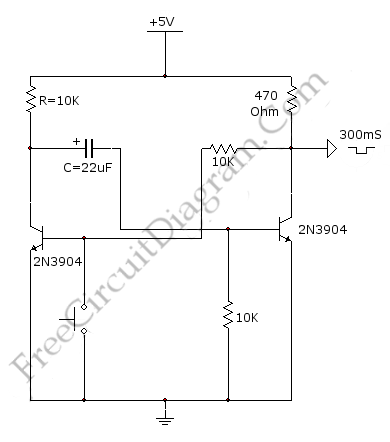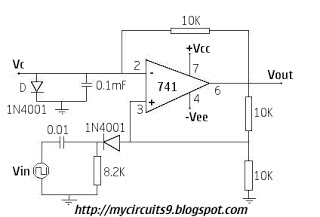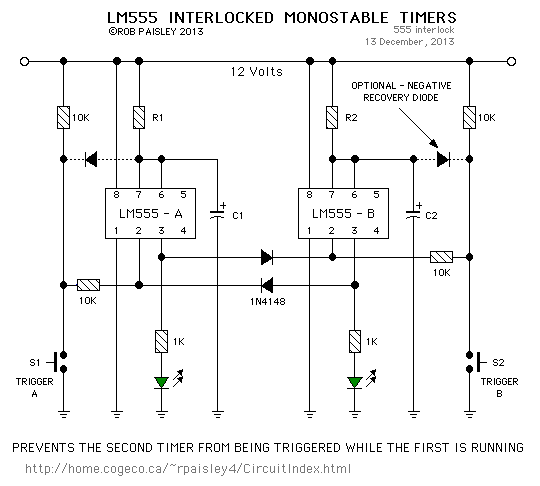
Monostable multivibrators
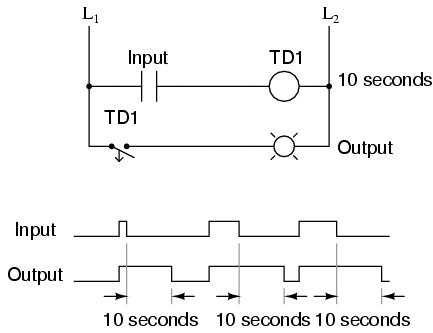
A monostable multivibrator is exemplified by the pulse detector within flip-flop circuitry, which briefly enables the latch portion during clock signal transitions. This device is classified as monostable due to its single stable state, which can maintain its output indefinitely without external input. In contrast, a bistable device, such as a latch or flip-flop, can hold either a "set" or "reset" state indefinitely until prompted to change by an external signal. Monostable devices can only maintain one state indefinitely, with their alternate state held momentarily when triggered. An analogy for a monostable device is a momentary contact pushbutton switch that returns to its stable position when released, whereas a toggle switch is bistable, latching in either the "on" or "off" position. Monostable multivibrators are timed devices, with their unstable output state persisting for a predetermined duration before reverting to the stable state. This timing function is typically achieved using resistors and capacitors in semiconductor circuits, utilizing the exponential charging rates of RC circuits. A comparator is used to compare the voltage across the capacitor with a steady reference voltage, generating a logic signal output. In ladder logic, time delays can be realized with time-delay relays, which may be constructed using semiconductor/RC circuits or mechanical delay devices that impede relay armature motion. In certain applications, a monostable device may need to output a longer pulse than the input pulse triggering it. For instance, in a ladder logic circuit, when an input contact closes, a time delay relay (TD1) closes and remains closed for 10 seconds after the input contact opens, ensuring the output remains high for this duration regardless of the input pulse length. This configuration is known as a one-shot, specifically a retriggerable one-shot, as timing begins after the input drops low, allowing multiple input pulses within 10 seconds to maintain a continuous high output. A practical application for a retriggerable one-shot is a mechanical contact debouncer, where the output remains high despite input signal bouncing. In real-world applications, a shorter time delay is typically desired for debouncing pulses in the millisecond range. For a 10-second timed pulse output from a relay logic circuit, independent of input pulse frequency or duration, a pulse-detector circuit can be coupled with a retriggerable one-shot time delay circuit. In this setup, time delay relay TD1 provides a brief "on" pulse to time delay relay coil TD2 each time the input contact is actuated. Once energized, the normally-closed, timed-closed TD2 contact prevents re-energization of coil TD2 during its 10-second timing period, making it unresponsive to further input switch actuations until timing completes. This configuration is termed a non-retriggerable one-shot. Both retriggerable and non-retriggerable one-shot multivibrators are extensively utilized in industry for applications such as siren actuation and machine sequencing, where intermittent input signals generate a fixed-duration output signal.
Monostable multivibrators, often implemented in digital circuits, serve critical functions in timing and pulse generation. Their design typically incorporates a resistor-capacitor (RC) network, which defines the timing characteristics. The resistor and capacitor work together to create a time constant, which determines how long the output remains in the unstable state before returning to stable. The voltage across the capacitor rises or falls exponentially, and the comparator monitors this voltage against a reference level to control the output state.
In practical applications, the selection of resistor and capacitor values is crucial for achieving the desired timing duration. For instance, if a 10-second pulse is required, appropriate values must be calculated based on the formula \( T = R \times C \), where \( T \) is the time in seconds, \( R \) is the resistance in ohms, and \( C \) is the capacitance in farads.
The implementation of a one-shot multivibrator in a ladder logic circuit involves careful consideration of the relay contacts' configuration. The interaction between the input signal, the timing relay, and the output relay must be designed to ensure that the output pulse duration is consistent with the operational requirements. In scenarios requiring debouncing, the retriggerable one-shot can effectively filter out noise from mechanical switches, ensuring stable operation in control systems.
Overall, monostable multivibrators are versatile components that enhance the reliability and functionality of electronic circuits, particularly in applications requiring precise timing and pulse control. Their ability to produce consistent output signals in response to variable input conditions makes them indispensable in modern electronic design.We`ve already seen one example of a monostable multivibrator in use: the pulse detector used within the circuitry of flip-flops, to enable the latch portion for a brief time when the clock input signal transitions from either low to high or high to low. The pulse detector is classified as a monostable multivibrator because it has only one stable s tate. By stable, I mean a state of output where the device is able to latch or hold to forever, without external prodding. A latch or flip-flop, being a bistable device, can hold in either the "set" or "reset" state for an indefinite period of time.
Once its set or reset, it will continue to latch in that state unless prompted to change by an external input. A monostable device, on the other hand, is only able to hold in one particular state indefinitely. Its other state can only be held momentarily when triggered by an external input. A mechanical analogy of a monostable device would be a momentary contact pushbutton switch, which spring-returns to its normal (stable) position when pressure is removed from its button actuator.
Likewise, a standard wall (toggle) switch, such as the type used to turn lights on and off in a house, is a bistable device. It can latch in one of two modes: on or off. All monostable multivibrators are timed devices. That is, their unstable output state will hold only for a certain minimum amount of time before returning to its stable state.
With semiconductor monostable circuits, this timing function is typically accomplished through the use of resistors and capacitors, making use of the exponential charging rates of RC circuits. A comparator is often used to compare the voltage across the charging (or discharging) capacitor with a steady reference voltage, and the on/off output of the comparator used for a logic signal.
With ladder logic, time delays are accomplished with time-delay relays, which can be constructed with semiconductor/RC circuits like that just mentioned, or mechanical delay devices which impede the immediate motion of the relay`s armature. Note the design and operation of the pulse detector circuit in ladder logic: For some applications, it is necessary to have a monostable device that outputs a longer pulse than the input pulse which triggers it.
Consider the following ladder logic circuit: When the input contact closes, TD1 contact immediately closes, and stays closed for 10 seconds after the input contact opens. No matter how short the input pulse is, the output stays high (1) for exactly 10 seconds after the input drops low again.
This kind of monostable multivibrator is called a one-shot. More specifically, it is a retriggerable one-shot, because the timing begins after the input drops to a low state, meaning that multiple input pulses within 10 seconds of each other will maintain a continuous high output: One application for a retriggerable one-shot is that of a single mechanical contact debouncer. As you can see from the above timing diagram, the output will remain high despite "bouncing" of the input signal from a mechanical switch.
Of course, in a real-life switch debouncer circuit, you`d probably want to use a time delay of much shorter duration than 10 seconds, as you only need to "debounce" pulses that are in the millisecond range. What if we only wanted a 10 second timed pulse output from a relay logic circuit, regardless of how many input pulses we received or how long-lived they may be In that case, we`d have to couple a pulse-detector circuit to the retriggerable one-shot time delay circuit, like this: Time delay relay TD1 provides an "on" pulse to time delay relay coil TD2 for an arbitrarily short moment (in this circuit, for at least 0.
5 second each time the input contact is actuated). As soon as TD2 is energized, the normally-closed, timed-closed TD2 contact in series with it prevents coil TD2 from being re-energized as long as its timing out (10 seconds). This effectively makes it unresponsive to any more actuations of the input switch during that 10 second period.
Only after TD2 times out does the normally-closed, timed-closed TD2 contact in series with it allow coil TD2 to be energized again. This type of one-shot is called a nonretriggerable one-shot. One-shot multivibrators of both the retriggerable and nonretriggerable variety find wide application in industry for siren actuation and machine sequencing, where an intermittent input signal produces an output signal of a set time.
🔗 External reference
Monostable multivibrators, often implemented in digital circuits, serve critical functions in timing and pulse generation. Their design typically incorporates a resistor-capacitor (RC) network, which defines the timing characteristics. The resistor and capacitor work together to create a time constant, which determines how long the output remains in the unstable state before returning to stable. The voltage across the capacitor rises or falls exponentially, and the comparator monitors this voltage against a reference level to control the output state.
In practical applications, the selection of resistor and capacitor values is crucial for achieving the desired timing duration. For instance, if a 10-second pulse is required, appropriate values must be calculated based on the formula \( T = R \times C \), where \( T \) is the time in seconds, \( R \) is the resistance in ohms, and \( C \) is the capacitance in farads.
The implementation of a one-shot multivibrator in a ladder logic circuit involves careful consideration of the relay contacts' configuration. The interaction between the input signal, the timing relay, and the output relay must be designed to ensure that the output pulse duration is consistent with the operational requirements. In scenarios requiring debouncing, the retriggerable one-shot can effectively filter out noise from mechanical switches, ensuring stable operation in control systems.
Overall, monostable multivibrators are versatile components that enhance the reliability and functionality of electronic circuits, particularly in applications requiring precise timing and pulse control. Their ability to produce consistent output signals in response to variable input conditions makes them indispensable in modern electronic design.We`ve already seen one example of a monostable multivibrator in use: the pulse detector used within the circuitry of flip-flops, to enable the latch portion for a brief time when the clock input signal transitions from either low to high or high to low. The pulse detector is classified as a monostable multivibrator because it has only one stable s tate. By stable, I mean a state of output where the device is able to latch or hold to forever, without external prodding. A latch or flip-flop, being a bistable device, can hold in either the "set" or "reset" state for an indefinite period of time.
Once its set or reset, it will continue to latch in that state unless prompted to change by an external input. A monostable device, on the other hand, is only able to hold in one particular state indefinitely. Its other state can only be held momentarily when triggered by an external input. A mechanical analogy of a monostable device would be a momentary contact pushbutton switch, which spring-returns to its normal (stable) position when pressure is removed from its button actuator.
Likewise, a standard wall (toggle) switch, such as the type used to turn lights on and off in a house, is a bistable device. It can latch in one of two modes: on or off. All monostable multivibrators are timed devices. That is, their unstable output state will hold only for a certain minimum amount of time before returning to its stable state.
With semiconductor monostable circuits, this timing function is typically accomplished through the use of resistors and capacitors, making use of the exponential charging rates of RC circuits. A comparator is often used to compare the voltage across the charging (or discharging) capacitor with a steady reference voltage, and the on/off output of the comparator used for a logic signal.
With ladder logic, time delays are accomplished with time-delay relays, which can be constructed with semiconductor/RC circuits like that just mentioned, or mechanical delay devices which impede the immediate motion of the relay`s armature. Note the design and operation of the pulse detector circuit in ladder logic: For some applications, it is necessary to have a monostable device that outputs a longer pulse than the input pulse which triggers it.
Consider the following ladder logic circuit: When the input contact closes, TD1 contact immediately closes, and stays closed for 10 seconds after the input contact opens. No matter how short the input pulse is, the output stays high (1) for exactly 10 seconds after the input drops low again.
This kind of monostable multivibrator is called a one-shot. More specifically, it is a retriggerable one-shot, because the timing begins after the input drops to a low state, meaning that multiple input pulses within 10 seconds of each other will maintain a continuous high output: One application for a retriggerable one-shot is that of a single mechanical contact debouncer. As you can see from the above timing diagram, the output will remain high despite "bouncing" of the input signal from a mechanical switch.
Of course, in a real-life switch debouncer circuit, you`d probably want to use a time delay of much shorter duration than 10 seconds, as you only need to "debounce" pulses that are in the millisecond range. What if we only wanted a 10 second timed pulse output from a relay logic circuit, regardless of how many input pulses we received or how long-lived they may be In that case, we`d have to couple a pulse-detector circuit to the retriggerable one-shot time delay circuit, like this: Time delay relay TD1 provides an "on" pulse to time delay relay coil TD2 for an arbitrarily short moment (in this circuit, for at least 0.
5 second each time the input contact is actuated). As soon as TD2 is energized, the normally-closed, timed-closed TD2 contact in series with it prevents coil TD2 from being re-energized as long as its timing out (10 seconds). This effectively makes it unresponsive to any more actuations of the input switch during that 10 second period.
Only after TD2 times out does the normally-closed, timed-closed TD2 contact in series with it allow coil TD2 to be energized again. This type of one-shot is called a nonretriggerable one-shot. One-shot multivibrators of both the retriggerable and nonretriggerable variety find wide application in industry for siren actuation and machine sequencing, where an intermittent input signal produces an output signal of a set time.
🔗 External reference
